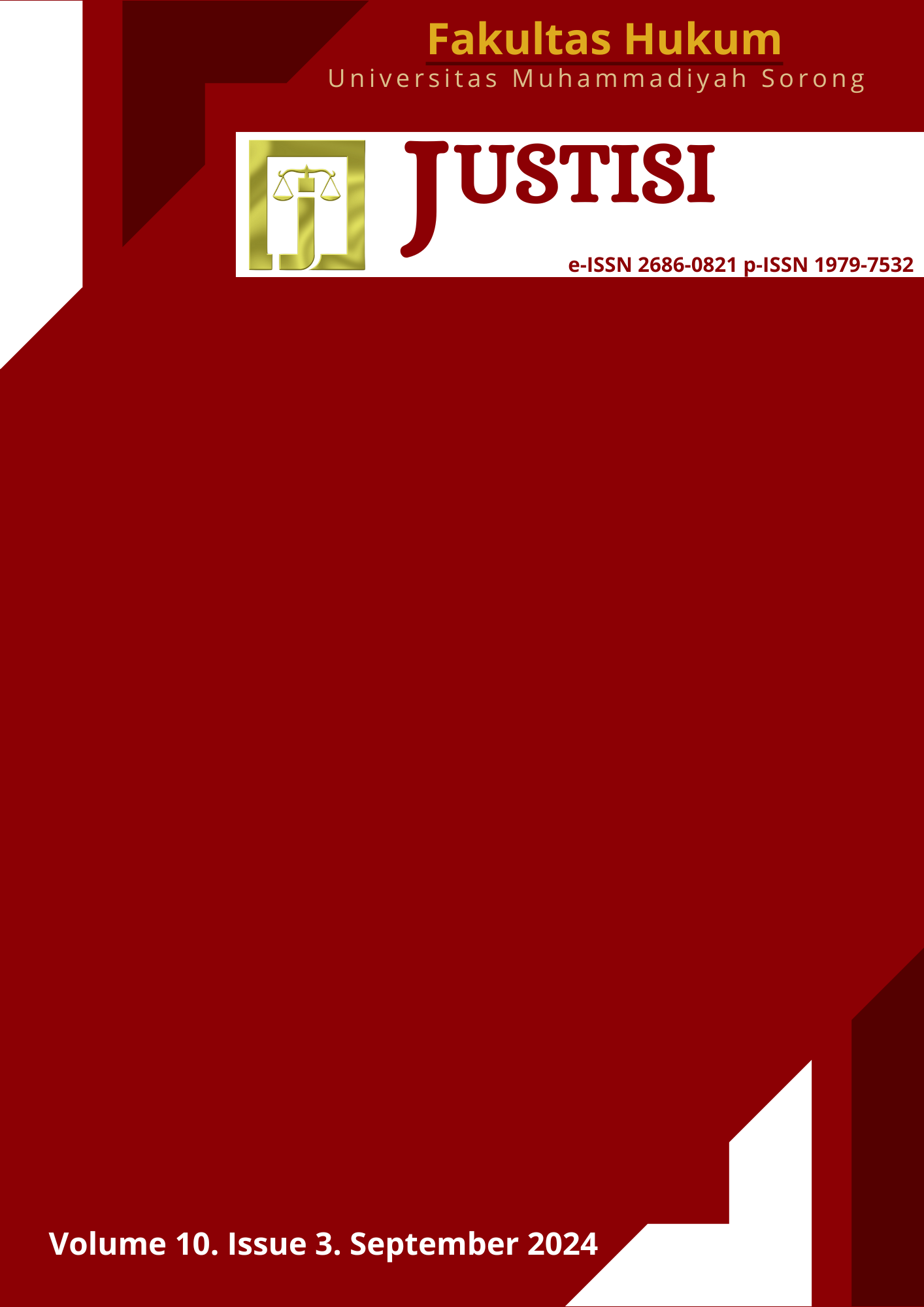The Legal Status of Circumstantial Evidence in the Context of Criminal Cases in Indonesia
DOI:
https://doi.org/10.33506/js.v10i3.3307Keywords:
Legal Status, Circumstantial Evidence, Criminal CasesAbstract
In practice, there are several instances of criminal decisions that are not in accordance with the law. In such instances, the judge interprets the law or legal findings based on circumstantial evidence. As a result, the action taken does not achieve the highest degree of justice and legal certainty in a decision. This is because the decision is not based on the minimum requirements of two pieces of evidence that must be met in terms of evidence to impose a sentence. The objective of this research was to analyze the legal status of circumstantial evidence in the context of criminal cases. Our research findings indicate that the philosophy of circumstantial evidence, as it pertains to criminal procedural law, represents a form of evidence that can be considered by judges in relation to the absence of facts that are not directly visible by eyewitnesses. This evidence is intended to provide a comprehensive depiction of the truth of an event, thereby facilitating the acceptance of a reasonable account of events. Establishing circumstantial evidence is distinct from providing instructions, however. To do so, one must obtain clues from facts presented at trial in the form of witness statements, letters and statements of the accused. The ius constituendum application of circumstantial evidence in the process of proving a criminal case is to provide the judge with the authority to utilise circumstantial evidence in the process of proving a crime as an additional legal means of evidence in sentencing. The role of indirect evidence in the imposition of criminal penalties is a doctrine that is confined to be the domain of legal experts.
References
Ante, Susanti. “Pembuktian Dan Putusan Pengadilan Dalam Acara Pidana.” Lex Crimen II, no. 2 (2013): 98–104.
Arifin, Samsul, Achmad Hariri, Satria Unggul Wicaksana Prakasa, and Asis Asis. 2024. “Cultural Radicalization Cons As an Effort to Eradicate the Crime of Terrorism in Indonesia”. JUSTISI 10 (2):417-28. https://doi.org/10.33506/js.v10i2.2935.
Farlex. “Indirect Evidence,” 2023. http://legal-dictionary.thefreedictionary.com/indirect+evidence.
Fira Mubayyinah. “Perbandingan Sistem Hukum Pembuktian Dalam Penanganan Perkara Tindak Korupsi Dengan Perkara Tindak Pidana Lainnya.” AL-HIKMAH Jurnal Study Keislaman 7, no. 1 (2017): 36–44. https://doi.org/https://doi.org/10.36835/hjsk.v7i1.3082.
H. Firman Freaddy Busroh. “‘Pembuktian Terbalik Dalam Tindak Pidana Korupsi.” Jurnal Hukum Tora 2, no. 2 (2016): 336–37.
Harun, Nurlaila. “Proses Peradilan Dan Arti Sebuah Keyakinan Hakim Dalam Memutus Suatu Perkara Di Pengadilan Agama Manado.” Jurnal Ilmiah Al-Syir’ah 15, no. 2 (2017): 167–92. https://doi.org/10.30984/as.v15i2.479.
Kusmiati, N Ike, Fakultas Hukum, and Universitas Pasundan. “Kekuatan Pembuktian Surat Berita Acara,” no. 01 (2001): 62–74.
Mardhatillah, Adam Bastian, and Ahmad Mahyani. “Bukti Tidak Langsung Sebagai Dasar Hakim Menjatuhkan Pidana.” Mimbar Keadilan 12, no. 1 (2019): 59–66.
Meta Suriyani. Pertentangan Asas Perundang-Undangan Dalam Pengaturan Larangan Mobilisasi Anak Pada Kampanye Pemilu, 2021.
Nur Prasetya Ningsih. 2024. “Criminological Analysis of Child Victims of Exploitation As Drug Couriers in Sorong City”. Journal of Law Justice (JLJ) 2 (2 August):133-49. https://doi.org/10.33506/jlj.v2i2 August.2801.
Pandiangan, Hendri Jayadi. “Perbedaan Hukum Pembuktian Dalam Perspektif Hukum Acara Pidana Dan Perdata.” To-Ra 3, no. 2 (2017): 565. https://doi.org/10.33541/tora.v3i2.1154.
Pangestu, Karunia, Heru Suyanto, and Rosalia Dika Agustanti. “Application of Circumstantial Evidence in Criminal Laws in Indonesia.” Jurnal Hukum Novelty 12, no. 1 (2021): 54–66. https://doi.org/10.26555/novelty.v12i01.a16996.
Perkosaan, Tindak Pidana. “Lexetsocietatis_dk28,+1.+Mutiara+Manaroinsong” IV, no. 9 (2016): 5–14.
Prameswari, Natralia, Samirah, and Yuliati Sri Wahyuningsih. “Kedudukan Alat Bukti Petunjuk Di Ranah Hukum Acara Pidana.” Jurnal Verstek 3, no. 2 (2015): 1–10.
Rozi, Fachrul. “Sistem Pembuktian Dalam Proses Persidangan Pada Perkara Tindak Pidana.” Jurnal Yuridis Unaja 1, no. 2 (2019): 19–33. https://doi.org/10.35141/jyu.v1i2.486.
Rusyadi, I. “Kekuatan Alat Bukti Dalam Persidangan Perkara Pidana.” Jurnal Hukum PRIORIS 5, no. 2 (2016): 128–34. https://doi.org/10.25105/prio.v5i2.558.
Safi. “Sistem Pembuktian Dalam Penanganan Perkara Perselisihan Hasil Pemilihan Umum Kepala Daerah Dan Wakil Kepala Daerah (Pemilukada) Di Mahkamah Kosntitusi.” Jurnal Dinamika Hukum, 11, no. 3 (2011): 499.
Santoyo. “Penegakan Hukum Di Indonesia.” Jurnal Dinamika Hukum 8, no. 3 (2008): 199–204.
Silalahi, Udin. “Pembuktian Perkara Kartel Di Indonesia Dengan Menggunakan Bukti Tidak Langsung (Indirect Evidence).” Jurnal Yudisial 10, no. 3 (2017): 311. https://doi.org/10.29123/jy.v10i3.216.
Siregar, Mahmul. “Bukti Tidak Langsung (Indirect Evidence) Dalam Penegakan Hukum Persaingan Usaha Di Indonesia.” Jurnal Hukum Samudra Keadilan 13, no. 2 (2018): 187–200. https://doi.org/10.33059/jhsk.v13i2.910.
Sucipta, Dwi Herman, and I Made Wirya Darma. “Amicus Curiae As the Development of Evidence in Criminal Procedure Code.” Jurnal Bina Mulia Hukum 7, no. 1 (2022): 17–30. https://doi.org/10.23920/jbmh.v7i1.576.
Susanti Ante. “Pembuktian Dan Putusan Pengadilan Dalam Acara Pidana.” Lex Crimen 2, no. 2 (2013): 100.
Wibawa Putra, Made Fajar Ari, and A.A.A.Ngurah Tini Rusmini Gorda. 2024. “Effectiveness of KPAI’s Role in Legal Protection of Children As Victims of Bullying Crime”. JUSTISI 10 (2):257-72. https://doi.org/10.33506/js.v10i2.2837.
Downloads
Published
How to Cite
Issue
Section
License
Copyright (c) 2024 Hari Wibowo, Dodi Jaya Wardana, Levina Yustitia, Hasnan Bachtiar

This work is licensed under a Creative Commons Attribution-ShareAlike 4.0 International License.











